University Human Resources Management: Solved Assignments 2014-2016
VerifiedAdded on 2020/03/16
|13
|3450
|40
Homework Assignment
AI Summary
This document presents a compilation of solved assignments in Human Resources Management from the years 2014 to 2016. The assignments cover a range of topics including flawed leadership, organizational behavior, cultural influences, and cognitive biases in decision-making. The solutions delve into leadership theories, such as trait theory, behavior theory, and situational leadership. Additionally, the assignments explore the impact of cultural dimensions, organizational development, and the importance of managing change effectively, including the application of Lewin's Change Management Model. The solutions also address the role of human resource management, strategic alignment, and various techniques for organizational decision-making like brainstorming and the Delphi method. The document provides comprehensive answers that demonstrate an understanding of HR principles and practical applications within a business context.
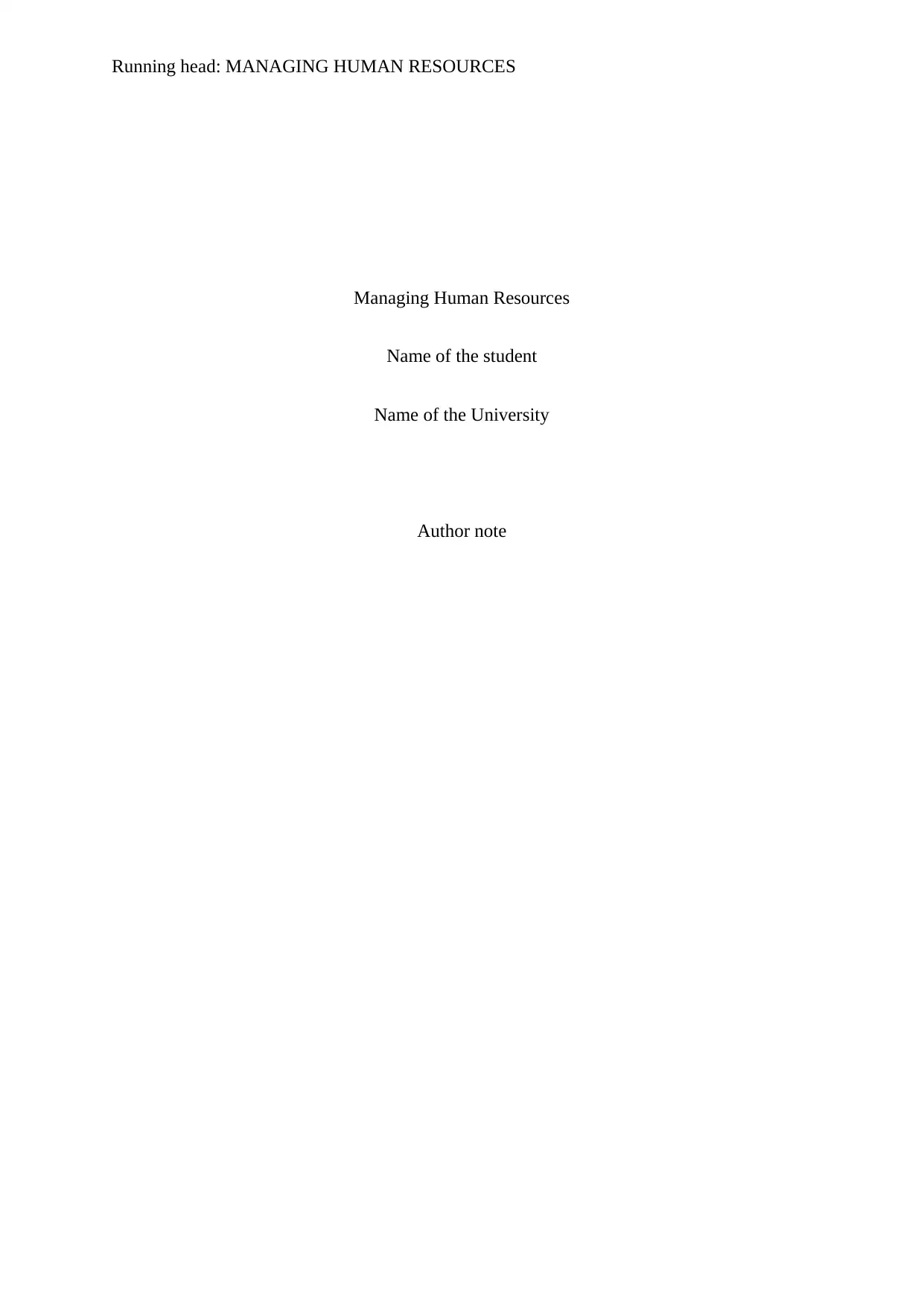
Running head: MANAGING HUMAN RESOURCES
Managing Human Resources
Name of the student
Name of the University
Author note
Managing Human Resources
Name of the student
Name of the University
Author note
Paraphrase This Document
Need a fresh take? Get an instant paraphrase of this document with our AI Paraphraser
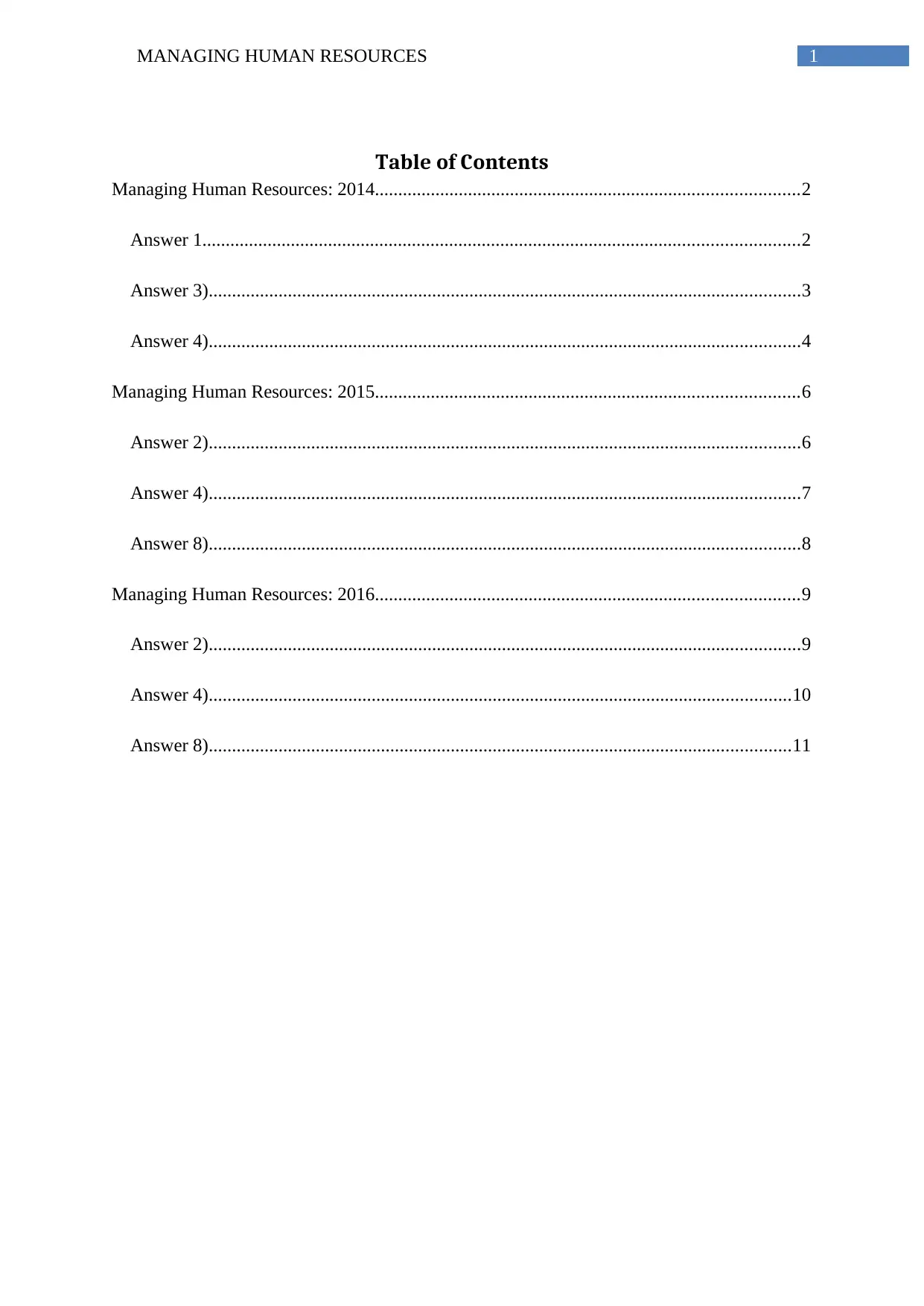
1MANAGING HUMAN RESOURCES
Table of Contents
Managing Human Resources: 2014...........................................................................................2
Answer 1................................................................................................................................2
Answer 3)...............................................................................................................................3
Answer 4)...............................................................................................................................4
Managing Human Resources: 2015...........................................................................................6
Answer 2)...............................................................................................................................6
Answer 4)...............................................................................................................................7
Answer 8)...............................................................................................................................8
Managing Human Resources: 2016...........................................................................................9
Answer 2)...............................................................................................................................9
Answer 4).............................................................................................................................10
Answer 8).............................................................................................................................11
Table of Contents
Managing Human Resources: 2014...........................................................................................2
Answer 1................................................................................................................................2
Answer 3)...............................................................................................................................3
Answer 4)...............................................................................................................................4
Managing Human Resources: 2015...........................................................................................6
Answer 2)...............................................................................................................................6
Answer 4)...............................................................................................................................7
Answer 8)...............................................................................................................................8
Managing Human Resources: 2016...........................................................................................9
Answer 2)...............................................................................................................................9
Answer 4).............................................................................................................................10
Answer 8).............................................................................................................................11
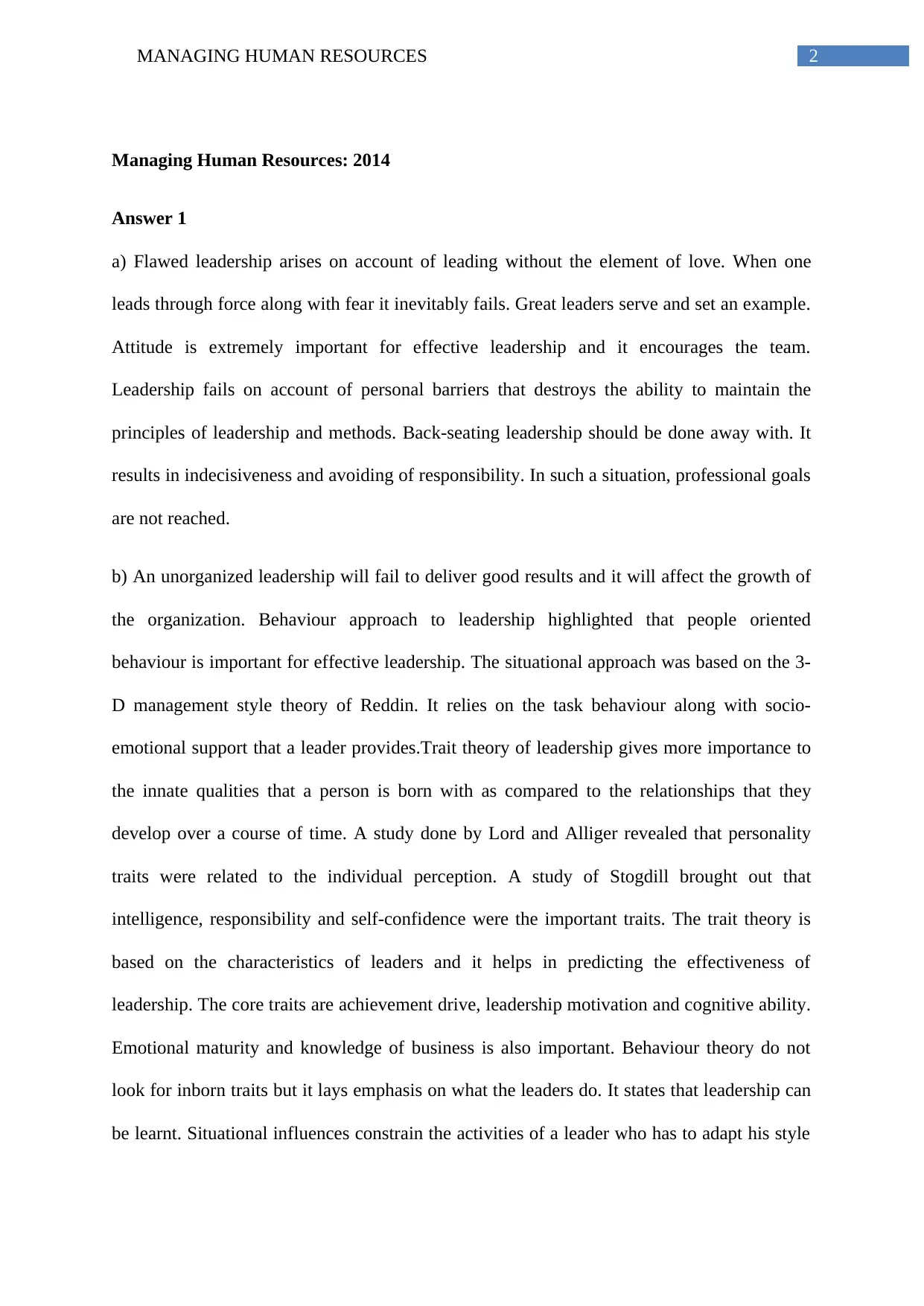
2MANAGING HUMAN RESOURCES
Managing Human Resources: 2014
Answer 1
a) Flawed leadership arises on account of leading without the element of love. When one
leads through force along with fear it inevitably fails. Great leaders serve and set an example.
Attitude is extremely important for effective leadership and it encourages the team.
Leadership fails on account of personal barriers that destroys the ability to maintain the
principles of leadership and methods. Back-seating leadership should be done away with. It
results in indecisiveness and avoiding of responsibility. In such a situation, professional goals
are not reached.
b) An unorganized leadership will fail to deliver good results and it will affect the growth of
the organization. Behaviour approach to leadership highlighted that people oriented
behaviour is important for effective leadership. The situational approach was based on the 3-
D management style theory of Reddin. It relies on the task behaviour along with socio-
emotional support that a leader provides.Trait theory of leadership gives more importance to
the innate qualities that a person is born with as compared to the relationships that they
develop over a course of time. A study done by Lord and Alliger revealed that personality
traits were related to the individual perception. A study of Stogdill brought out that
intelligence, responsibility and self-confidence were the important traits. The trait theory is
based on the characteristics of leaders and it helps in predicting the effectiveness of
leadership. The core traits are achievement drive, leadership motivation and cognitive ability.
Emotional maturity and knowledge of business is also important. Behaviour theory do not
look for inborn traits but it lays emphasis on what the leaders do. It states that leadership can
be learnt. Situational influences constrain the activities of a leader who has to adapt his style
Managing Human Resources: 2014
Answer 1
a) Flawed leadership arises on account of leading without the element of love. When one
leads through force along with fear it inevitably fails. Great leaders serve and set an example.
Attitude is extremely important for effective leadership and it encourages the team.
Leadership fails on account of personal barriers that destroys the ability to maintain the
principles of leadership and methods. Back-seating leadership should be done away with. It
results in indecisiveness and avoiding of responsibility. In such a situation, professional goals
are not reached.
b) An unorganized leadership will fail to deliver good results and it will affect the growth of
the organization. Behaviour approach to leadership highlighted that people oriented
behaviour is important for effective leadership. The situational approach was based on the 3-
D management style theory of Reddin. It relies on the task behaviour along with socio-
emotional support that a leader provides.Trait theory of leadership gives more importance to
the innate qualities that a person is born with as compared to the relationships that they
develop over a course of time. A study done by Lord and Alliger revealed that personality
traits were related to the individual perception. A study of Stogdill brought out that
intelligence, responsibility and self-confidence were the important traits. The trait theory is
based on the characteristics of leaders and it helps in predicting the effectiveness of
leadership. The core traits are achievement drive, leadership motivation and cognitive ability.
Emotional maturity and knowledge of business is also important. Behaviour theory do not
look for inborn traits but it lays emphasis on what the leaders do. It states that leadership can
be learnt. Situational influences constrain the activities of a leader who has to adapt his style
⊘ This is a preview!⊘
Do you want full access?
Subscribe today to unlock all pages.

Trusted by 1+ million students worldwide
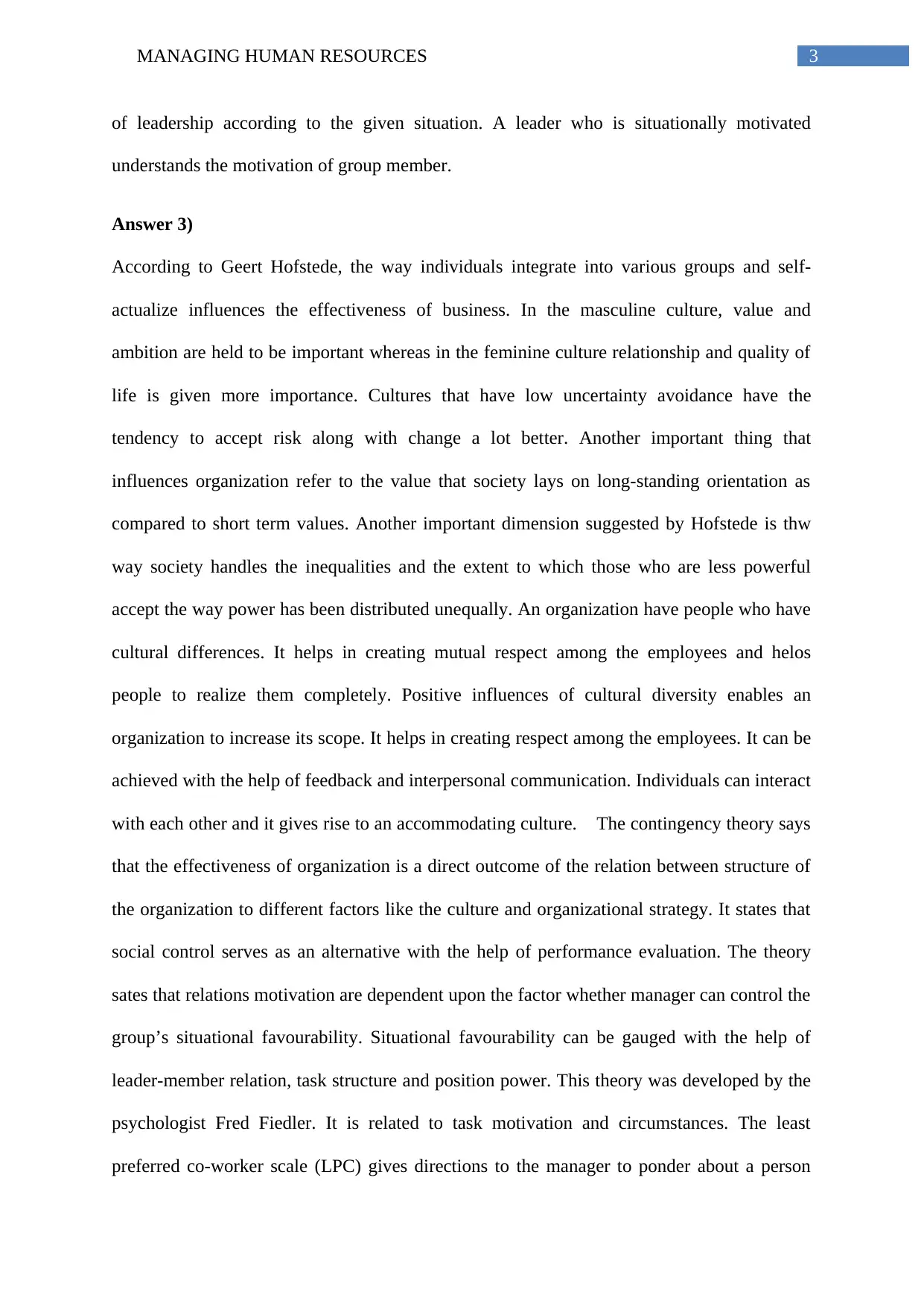
3MANAGING HUMAN RESOURCES
of leadership according to the given situation. A leader who is situationally motivated
understands the motivation of group member.
Answer 3)
According to Geert Hofstede, the way individuals integrate into various groups and self-
actualize influences the effectiveness of business. In the masculine culture, value and
ambition are held to be important whereas in the feminine culture relationship and quality of
life is given more importance. Cultures that have low uncertainty avoidance have the
tendency to accept risk along with change a lot better. Another important thing that
influences organization refer to the value that society lays on long-standing orientation as
compared to short term values. Another important dimension suggested by Hofstede is thw
way society handles the inequalities and the extent to which those who are less powerful
accept the way power has been distributed unequally. An organization have people who have
cultural differences. It helps in creating mutual respect among the employees and helos
people to realize them completely. Positive influences of cultural diversity enables an
organization to increase its scope. It helps in creating respect among the employees. It can be
achieved with the help of feedback and interpersonal communication. Individuals can interact
with each other and it gives rise to an accommodating culture. The contingency theory says
that the effectiveness of organization is a direct outcome of the relation between structure of
the organization to different factors like the culture and organizational strategy. It states that
social control serves as an alternative with the help of performance evaluation. The theory
sates that relations motivation are dependent upon the factor whether manager can control the
group’s situational favourability. Situational favourability can be gauged with the help of
leader-member relation, task structure and position power. This theory was developed by the
psychologist Fred Fiedler. It is related to task motivation and circumstances. The least
preferred co-worker scale (LPC) gives directions to the manager to ponder about a person
of leadership according to the given situation. A leader who is situationally motivated
understands the motivation of group member.
Answer 3)
According to Geert Hofstede, the way individuals integrate into various groups and self-
actualize influences the effectiveness of business. In the masculine culture, value and
ambition are held to be important whereas in the feminine culture relationship and quality of
life is given more importance. Cultures that have low uncertainty avoidance have the
tendency to accept risk along with change a lot better. Another important thing that
influences organization refer to the value that society lays on long-standing orientation as
compared to short term values. Another important dimension suggested by Hofstede is thw
way society handles the inequalities and the extent to which those who are less powerful
accept the way power has been distributed unequally. An organization have people who have
cultural differences. It helps in creating mutual respect among the employees and helos
people to realize them completely. Positive influences of cultural diversity enables an
organization to increase its scope. It helps in creating respect among the employees. It can be
achieved with the help of feedback and interpersonal communication. Individuals can interact
with each other and it gives rise to an accommodating culture. The contingency theory says
that the effectiveness of organization is a direct outcome of the relation between structure of
the organization to different factors like the culture and organizational strategy. It states that
social control serves as an alternative with the help of performance evaluation. The theory
sates that relations motivation are dependent upon the factor whether manager can control the
group’s situational favourability. Situational favourability can be gauged with the help of
leader-member relation, task structure and position power. This theory was developed by the
psychologist Fred Fiedler. It is related to task motivation and circumstances. The least
preferred co-worker scale (LPC) gives directions to the manager to ponder about a person
Paraphrase This Document
Need a fresh take? Get an instant paraphrase of this document with our AI Paraphraser
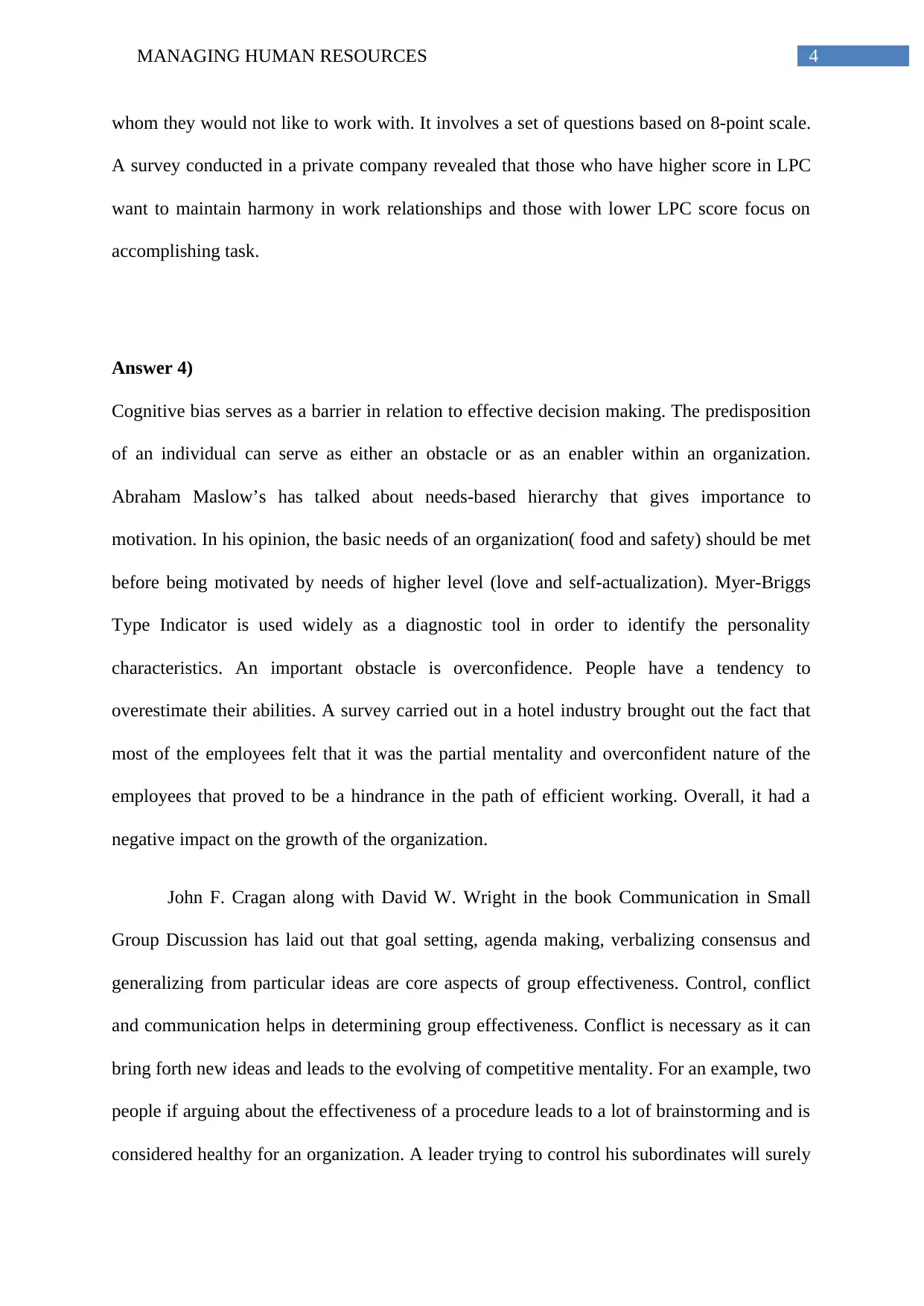
4MANAGING HUMAN RESOURCES
whom they would not like to work with. It involves a set of questions based on 8-point scale.
A survey conducted in a private company revealed that those who have higher score in LPC
want to maintain harmony in work relationships and those with lower LPC score focus on
accomplishing task.
Answer 4)
Cognitive bias serves as a barrier in relation to effective decision making. The predisposition
of an individual can serve as either an obstacle or as an enabler within an organization.
Abraham Maslow’s has talked about needs-based hierarchy that gives importance to
motivation. In his opinion, the basic needs of an organization( food and safety) should be met
before being motivated by needs of higher level (love and self-actualization). Myer-Briggs
Type Indicator is used widely as a diagnostic tool in order to identify the personality
characteristics. An important obstacle is overconfidence. People have a tendency to
overestimate their abilities. A survey carried out in a hotel industry brought out the fact that
most of the employees felt that it was the partial mentality and overconfident nature of the
employees that proved to be a hindrance in the path of efficient working. Overall, it had a
negative impact on the growth of the organization.
John F. Cragan along with David W. Wright in the book Communication in Small
Group Discussion has laid out that goal setting, agenda making, verbalizing consensus and
generalizing from particular ideas are core aspects of group effectiveness. Control, conflict
and communication helps in determining group effectiveness. Conflict is necessary as it can
bring forth new ideas and leads to the evolving of competitive mentality. For an example, two
people if arguing about the effectiveness of a procedure leads to a lot of brainstorming and is
considered healthy for an organization. A leader trying to control his subordinates will surely
whom they would not like to work with. It involves a set of questions based on 8-point scale.
A survey conducted in a private company revealed that those who have higher score in LPC
want to maintain harmony in work relationships and those with lower LPC score focus on
accomplishing task.
Answer 4)
Cognitive bias serves as a barrier in relation to effective decision making. The predisposition
of an individual can serve as either an obstacle or as an enabler within an organization.
Abraham Maslow’s has talked about needs-based hierarchy that gives importance to
motivation. In his opinion, the basic needs of an organization( food and safety) should be met
before being motivated by needs of higher level (love and self-actualization). Myer-Briggs
Type Indicator is used widely as a diagnostic tool in order to identify the personality
characteristics. An important obstacle is overconfidence. People have a tendency to
overestimate their abilities. A survey carried out in a hotel industry brought out the fact that
most of the employees felt that it was the partial mentality and overconfident nature of the
employees that proved to be a hindrance in the path of efficient working. Overall, it had a
negative impact on the growth of the organization.
John F. Cragan along with David W. Wright in the book Communication in Small
Group Discussion has laid out that goal setting, agenda making, verbalizing consensus and
generalizing from particular ideas are core aspects of group effectiveness. Control, conflict
and communication helps in determining group effectiveness. Conflict is necessary as it can
bring forth new ideas and leads to the evolving of competitive mentality. For an example, two
people if arguing about the effectiveness of a procedure leads to a lot of brainstorming and is
considered healthy for an organization. A leader trying to control his subordinates will surely
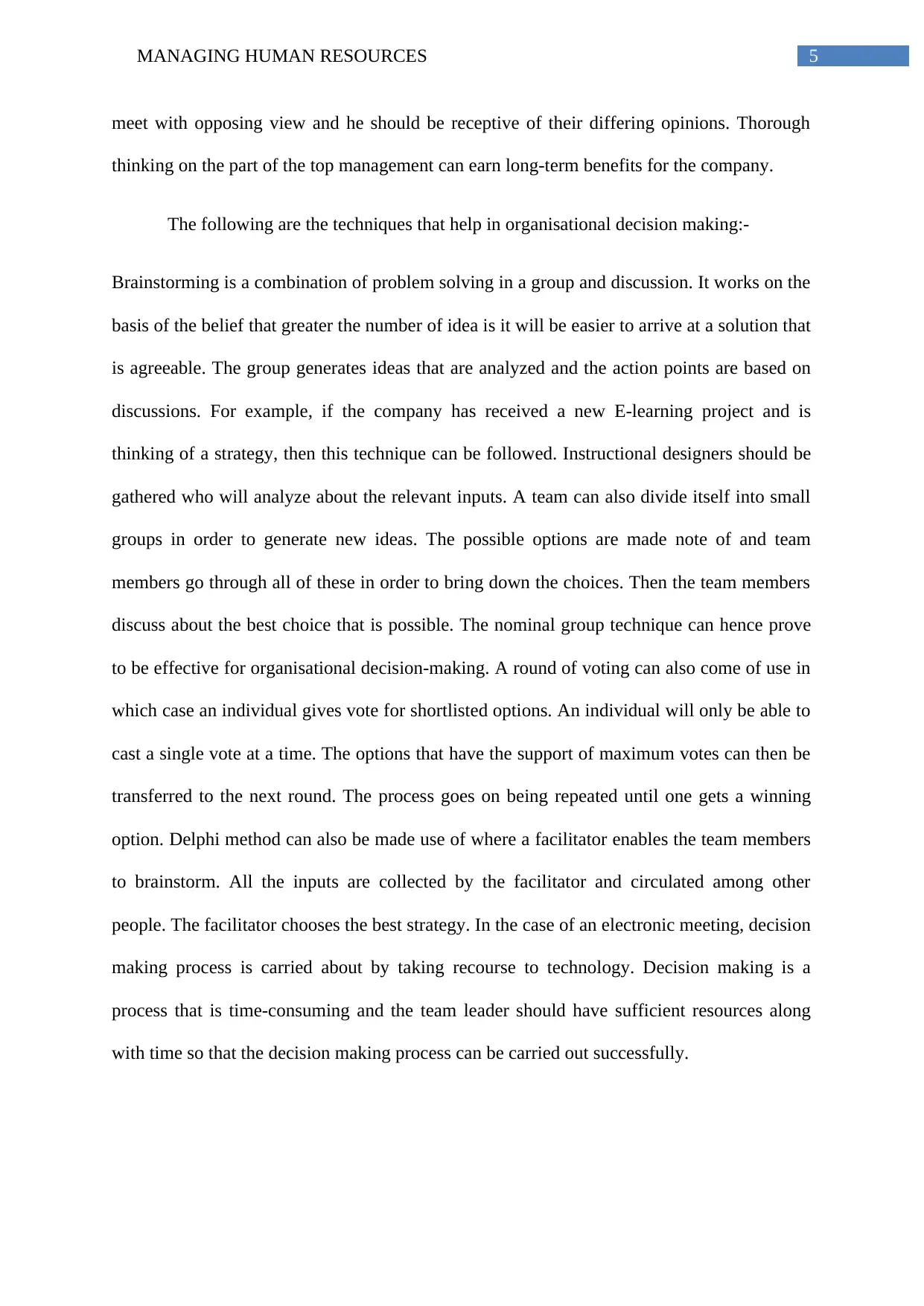
5MANAGING HUMAN RESOURCES
meet with opposing view and he should be receptive of their differing opinions. Thorough
thinking on the part of the top management can earn long-term benefits for the company.
The following are the techniques that help in organisational decision making:-
Brainstorming is a combination of problem solving in a group and discussion. It works on the
basis of the belief that greater the number of idea is it will be easier to arrive at a solution that
is agreeable. The group generates ideas that are analyzed and the action points are based on
discussions. For example, if the company has received a new E-learning project and is
thinking of a strategy, then this technique can be followed. Instructional designers should be
gathered who will analyze about the relevant inputs. A team can also divide itself into small
groups in order to generate new ideas. The possible options are made note of and team
members go through all of these in order to bring down the choices. Then the team members
discuss about the best choice that is possible. The nominal group technique can hence prove
to be effective for organisational decision-making. A round of voting can also come of use in
which case an individual gives vote for shortlisted options. An individual will only be able to
cast a single vote at a time. The options that have the support of maximum votes can then be
transferred to the next round. The process goes on being repeated until one gets a winning
option. Delphi method can also be made use of where a facilitator enables the team members
to brainstorm. All the inputs are collected by the facilitator and circulated among other
people. The facilitator chooses the best strategy. In the case of an electronic meeting, decision
making process is carried about by taking recourse to technology. Decision making is a
process that is time-consuming and the team leader should have sufficient resources along
with time so that the decision making process can be carried out successfully.
meet with opposing view and he should be receptive of their differing opinions. Thorough
thinking on the part of the top management can earn long-term benefits for the company.
The following are the techniques that help in organisational decision making:-
Brainstorming is a combination of problem solving in a group and discussion. It works on the
basis of the belief that greater the number of idea is it will be easier to arrive at a solution that
is agreeable. The group generates ideas that are analyzed and the action points are based on
discussions. For example, if the company has received a new E-learning project and is
thinking of a strategy, then this technique can be followed. Instructional designers should be
gathered who will analyze about the relevant inputs. A team can also divide itself into small
groups in order to generate new ideas. The possible options are made note of and team
members go through all of these in order to bring down the choices. Then the team members
discuss about the best choice that is possible. The nominal group technique can hence prove
to be effective for organisational decision-making. A round of voting can also come of use in
which case an individual gives vote for shortlisted options. An individual will only be able to
cast a single vote at a time. The options that have the support of maximum votes can then be
transferred to the next round. The process goes on being repeated until one gets a winning
option. Delphi method can also be made use of where a facilitator enables the team members
to brainstorm. All the inputs are collected by the facilitator and circulated among other
people. The facilitator chooses the best strategy. In the case of an electronic meeting, decision
making process is carried about by taking recourse to technology. Decision making is a
process that is time-consuming and the team leader should have sufficient resources along
with time so that the decision making process can be carried out successfully.
⊘ This is a preview!⊘
Do you want full access?
Subscribe today to unlock all pages.

Trusted by 1+ million students worldwide
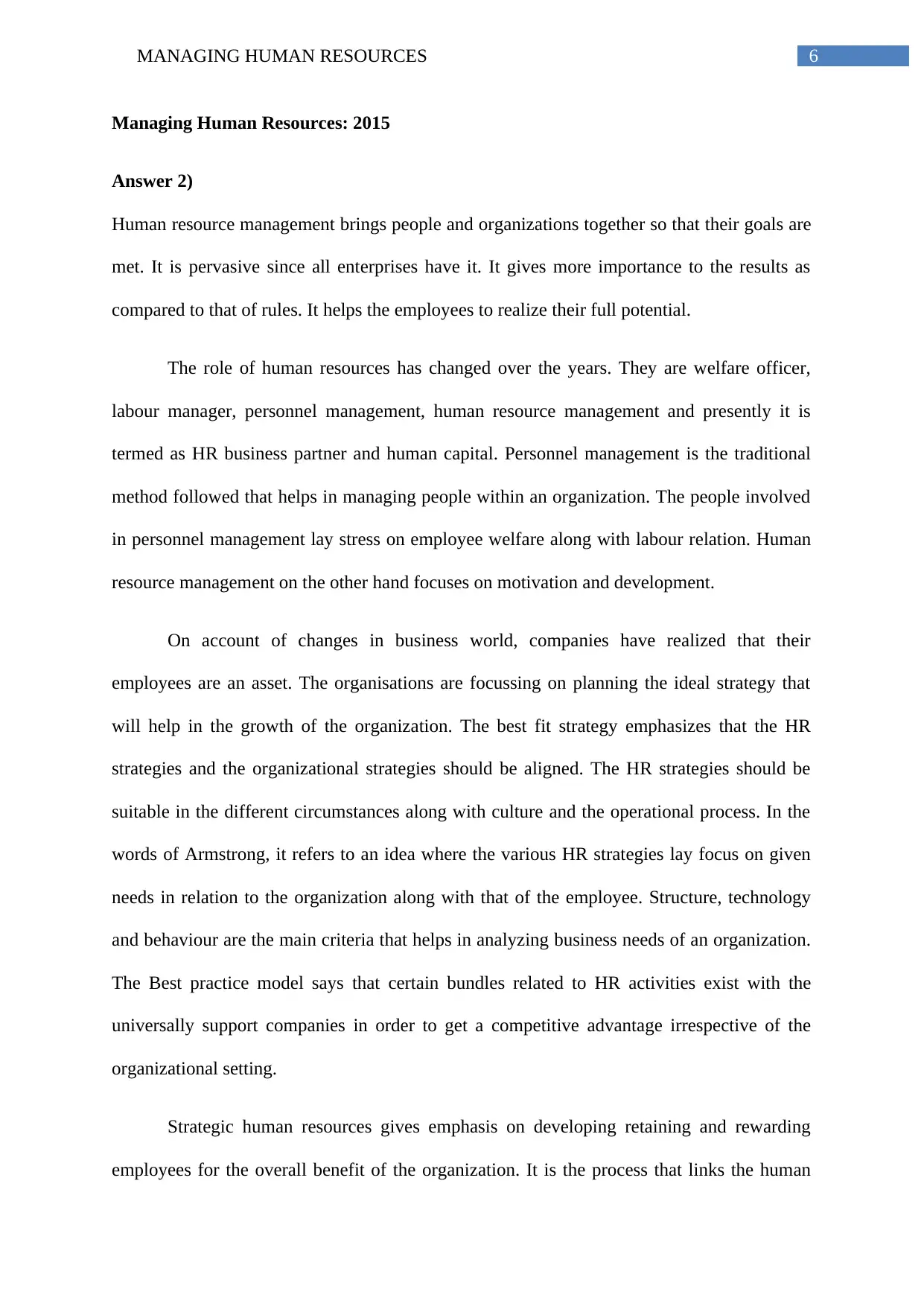
6MANAGING HUMAN RESOURCES
Managing Human Resources: 2015
Answer 2)
Human resource management brings people and organizations together so that their goals are
met. It is pervasive since all enterprises have it. It gives more importance to the results as
compared to that of rules. It helps the employees to realize their full potential.
The role of human resources has changed over the years. They are welfare officer,
labour manager, personnel management, human resource management and presently it is
termed as HR business partner and human capital. Personnel management is the traditional
method followed that helps in managing people within an organization. The people involved
in personnel management lay stress on employee welfare along with labour relation. Human
resource management on the other hand focuses on motivation and development.
On account of changes in business world, companies have realized that their
employees are an asset. The organisations are focussing on planning the ideal strategy that
will help in the growth of the organization. The best fit strategy emphasizes that the HR
strategies and the organizational strategies should be aligned. The HR strategies should be
suitable in the different circumstances along with culture and the operational process. In the
words of Armstrong, it refers to an idea where the various HR strategies lay focus on given
needs in relation to the organization along with that of the employee. Structure, technology
and behaviour are the main criteria that helps in analyzing business needs of an organization.
The Best practice model says that certain bundles related to HR activities exist with the
universally support companies in order to get a competitive advantage irrespective of the
organizational setting.
Strategic human resources gives emphasis on developing retaining and rewarding
employees for the overall benefit of the organization. It is the process that links the human
Managing Human Resources: 2015
Answer 2)
Human resource management brings people and organizations together so that their goals are
met. It is pervasive since all enterprises have it. It gives more importance to the results as
compared to that of rules. It helps the employees to realize their full potential.
The role of human resources has changed over the years. They are welfare officer,
labour manager, personnel management, human resource management and presently it is
termed as HR business partner and human capital. Personnel management is the traditional
method followed that helps in managing people within an organization. The people involved
in personnel management lay stress on employee welfare along with labour relation. Human
resource management on the other hand focuses on motivation and development.
On account of changes in business world, companies have realized that their
employees are an asset. The organisations are focussing on planning the ideal strategy that
will help in the growth of the organization. The best fit strategy emphasizes that the HR
strategies and the organizational strategies should be aligned. The HR strategies should be
suitable in the different circumstances along with culture and the operational process. In the
words of Armstrong, it refers to an idea where the various HR strategies lay focus on given
needs in relation to the organization along with that of the employee. Structure, technology
and behaviour are the main criteria that helps in analyzing business needs of an organization.
The Best practice model says that certain bundles related to HR activities exist with the
universally support companies in order to get a competitive advantage irrespective of the
organizational setting.
Strategic human resources gives emphasis on developing retaining and rewarding
employees for the overall benefit of the organization. It is the process that links the human
Paraphrase This Document
Need a fresh take? Get an instant paraphrase of this document with our AI Paraphraser
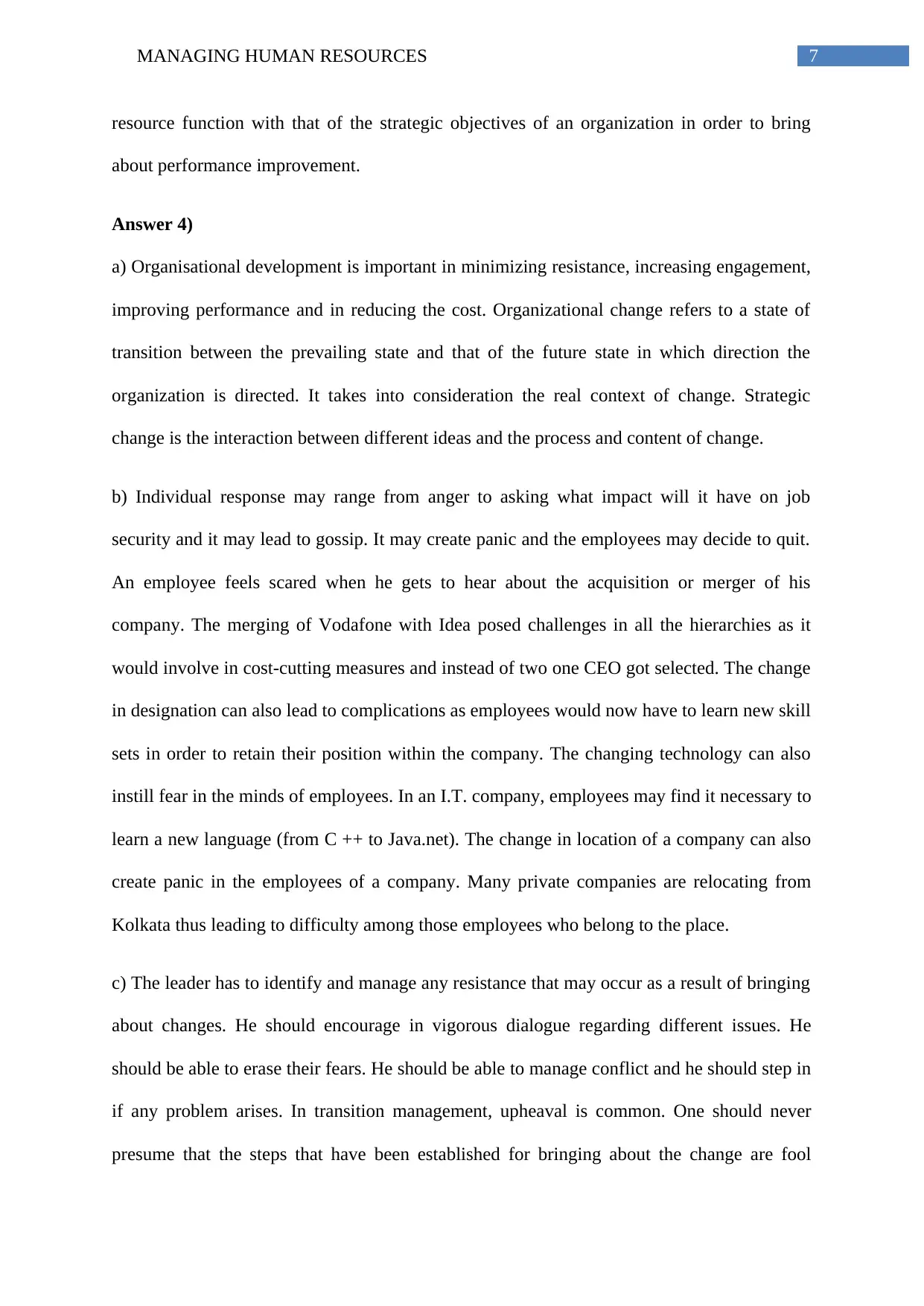
7MANAGING HUMAN RESOURCES
resource function with that of the strategic objectives of an organization in order to bring
about performance improvement.
Answer 4)
a) Organisational development is important in minimizing resistance, increasing engagement,
improving performance and in reducing the cost. Organizational change refers to a state of
transition between the prevailing state and that of the future state in which direction the
organization is directed. It takes into consideration the real context of change. Strategic
change is the interaction between different ideas and the process and content of change.
b) Individual response may range from anger to asking what impact will it have on job
security and it may lead to gossip. It may create panic and the employees may decide to quit.
An employee feels scared when he gets to hear about the acquisition or merger of his
company. The merging of Vodafone with Idea posed challenges in all the hierarchies as it
would involve in cost-cutting measures and instead of two one CEO got selected. The change
in designation can also lead to complications as employees would now have to learn new skill
sets in order to retain their position within the company. The changing technology can also
instill fear in the minds of employees. In an I.T. company, employees may find it necessary to
learn a new language (from C ++ to Java.net). The change in location of a company can also
create panic in the employees of a company. Many private companies are relocating from
Kolkata thus leading to difficulty among those employees who belong to the place.
c) The leader has to identify and manage any resistance that may occur as a result of bringing
about changes. He should encourage in vigorous dialogue regarding different issues. He
should be able to erase their fears. He should be able to manage conflict and he should step in
if any problem arises. In transition management, upheaval is common. One should never
presume that the steps that have been established for bringing about the change are fool
resource function with that of the strategic objectives of an organization in order to bring
about performance improvement.
Answer 4)
a) Organisational development is important in minimizing resistance, increasing engagement,
improving performance and in reducing the cost. Organizational change refers to a state of
transition between the prevailing state and that of the future state in which direction the
organization is directed. It takes into consideration the real context of change. Strategic
change is the interaction between different ideas and the process and content of change.
b) Individual response may range from anger to asking what impact will it have on job
security and it may lead to gossip. It may create panic and the employees may decide to quit.
An employee feels scared when he gets to hear about the acquisition or merger of his
company. The merging of Vodafone with Idea posed challenges in all the hierarchies as it
would involve in cost-cutting measures and instead of two one CEO got selected. The change
in designation can also lead to complications as employees would now have to learn new skill
sets in order to retain their position within the company. The changing technology can also
instill fear in the minds of employees. In an I.T. company, employees may find it necessary to
learn a new language (from C ++ to Java.net). The change in location of a company can also
create panic in the employees of a company. Many private companies are relocating from
Kolkata thus leading to difficulty among those employees who belong to the place.
c) The leader has to identify and manage any resistance that may occur as a result of bringing
about changes. He should encourage in vigorous dialogue regarding different issues. He
should be able to erase their fears. He should be able to manage conflict and he should step in
if any problem arises. In transition management, upheaval is common. One should never
presume that the steps that have been established for bringing about the change are fool
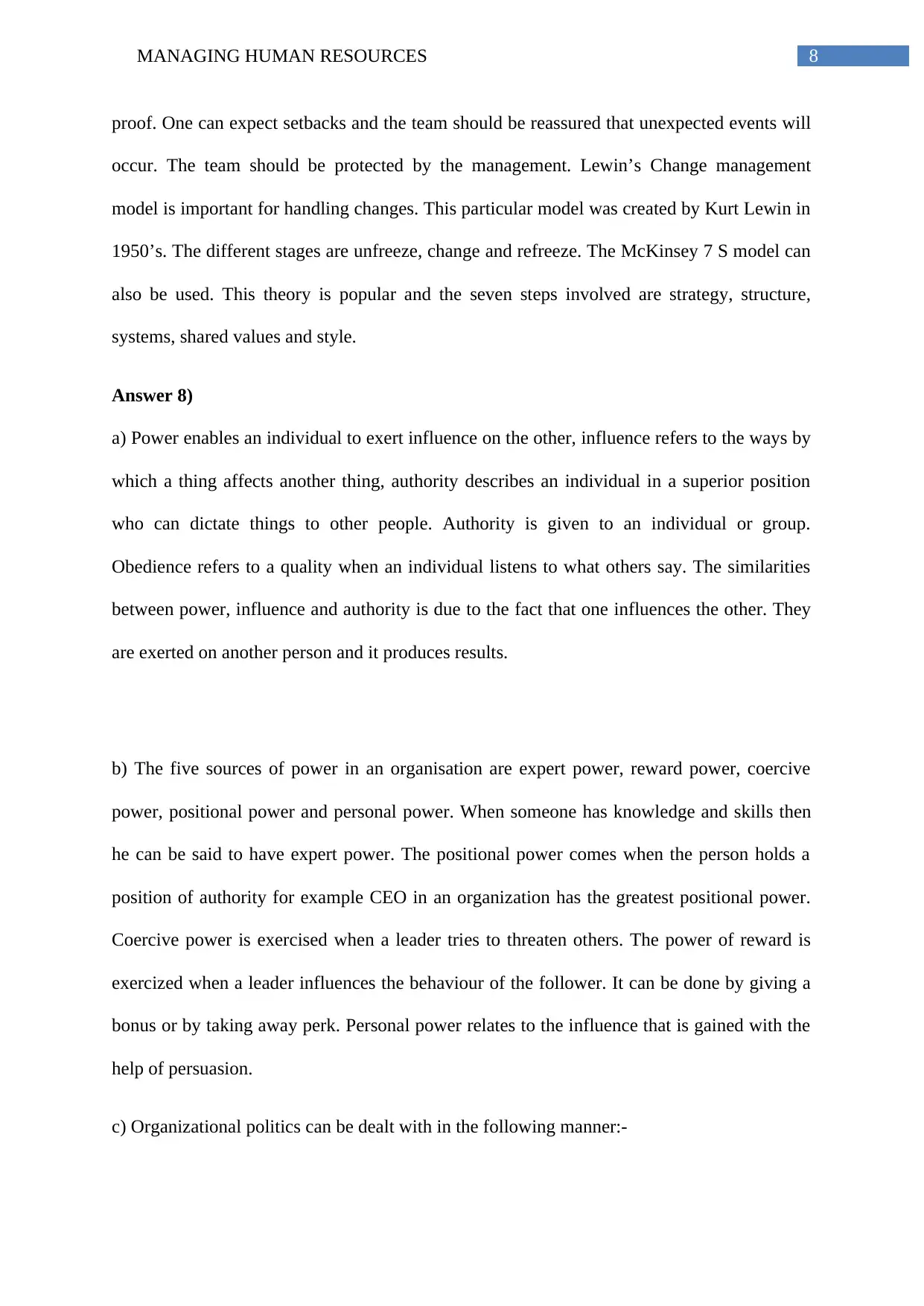
8MANAGING HUMAN RESOURCES
proof. One can expect setbacks and the team should be reassured that unexpected events will
occur. The team should be protected by the management. Lewin’s Change management
model is important for handling changes. This particular model was created by Kurt Lewin in
1950’s. The different stages are unfreeze, change and refreeze. The McKinsey 7 S model can
also be used. This theory is popular and the seven steps involved are strategy, structure,
systems, shared values and style.
Answer 8)
a) Power enables an individual to exert influence on the other, influence refers to the ways by
which a thing affects another thing, authority describes an individual in a superior position
who can dictate things to other people. Authority is given to an individual or group.
Obedience refers to a quality when an individual listens to what others say. The similarities
between power, influence and authority is due to the fact that one influences the other. They
are exerted on another person and it produces results.
b) The five sources of power in an organisation are expert power, reward power, coercive
power, positional power and personal power. When someone has knowledge and skills then
he can be said to have expert power. The positional power comes when the person holds a
position of authority for example CEO in an organization has the greatest positional power.
Coercive power is exercised when a leader tries to threaten others. The power of reward is
exercized when a leader influences the behaviour of the follower. It can be done by giving a
bonus or by taking away perk. Personal power relates to the influence that is gained with the
help of persuasion.
c) Organizational politics can be dealt with in the following manner:-
proof. One can expect setbacks and the team should be reassured that unexpected events will
occur. The team should be protected by the management. Lewin’s Change management
model is important for handling changes. This particular model was created by Kurt Lewin in
1950’s. The different stages are unfreeze, change and refreeze. The McKinsey 7 S model can
also be used. This theory is popular and the seven steps involved are strategy, structure,
systems, shared values and style.
Answer 8)
a) Power enables an individual to exert influence on the other, influence refers to the ways by
which a thing affects another thing, authority describes an individual in a superior position
who can dictate things to other people. Authority is given to an individual or group.
Obedience refers to a quality when an individual listens to what others say. The similarities
between power, influence and authority is due to the fact that one influences the other. They
are exerted on another person and it produces results.
b) The five sources of power in an organisation are expert power, reward power, coercive
power, positional power and personal power. When someone has knowledge and skills then
he can be said to have expert power. The positional power comes when the person holds a
position of authority for example CEO in an organization has the greatest positional power.
Coercive power is exercised when a leader tries to threaten others. The power of reward is
exercized when a leader influences the behaviour of the follower. It can be done by giving a
bonus or by taking away perk. Personal power relates to the influence that is gained with the
help of persuasion.
c) Organizational politics can be dealt with in the following manner:-
⊘ This is a preview!⊘
Do you want full access?
Subscribe today to unlock all pages.

Trusted by 1+ million students worldwide
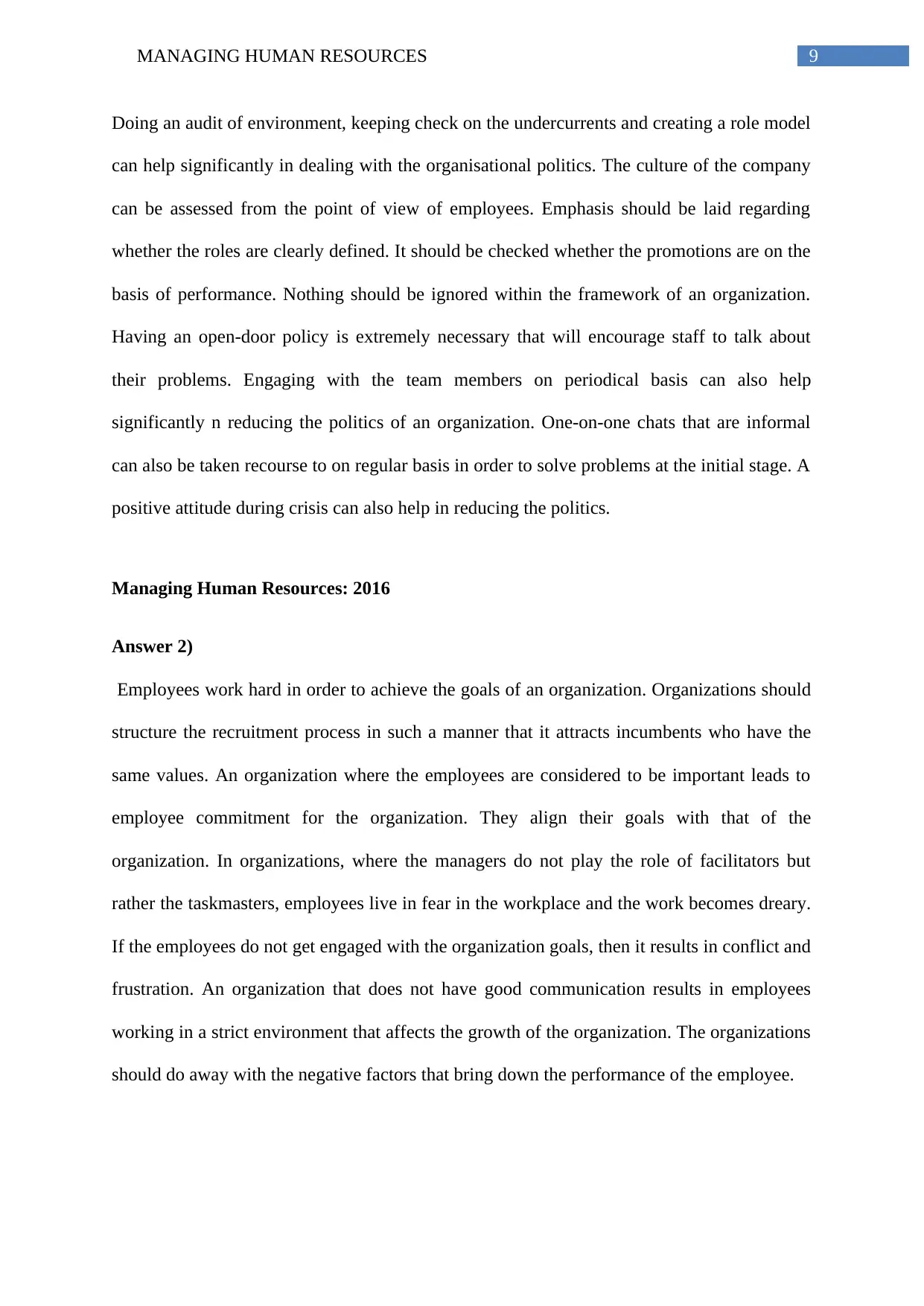
9MANAGING HUMAN RESOURCES
Doing an audit of environment, keeping check on the undercurrents and creating a role model
can help significantly in dealing with the organisational politics. The culture of the company
can be assessed from the point of view of employees. Emphasis should be laid regarding
whether the roles are clearly defined. It should be checked whether the promotions are on the
basis of performance. Nothing should be ignored within the framework of an organization.
Having an open-door policy is extremely necessary that will encourage staff to talk about
their problems. Engaging with the team members on periodical basis can also help
significantly n reducing the politics of an organization. One-on-one chats that are informal
can also be taken recourse to on regular basis in order to solve problems at the initial stage. A
positive attitude during crisis can also help in reducing the politics.
Managing Human Resources: 2016
Answer 2)
Employees work hard in order to achieve the goals of an organization. Organizations should
structure the recruitment process in such a manner that it attracts incumbents who have the
same values. An organization where the employees are considered to be important leads to
employee commitment for the organization. They align their goals with that of the
organization. In organizations, where the managers do not play the role of facilitators but
rather the taskmasters, employees live in fear in the workplace and the work becomes dreary.
If the employees do not get engaged with the organization goals, then it results in conflict and
frustration. An organization that does not have good communication results in employees
working in a strict environment that affects the growth of the organization. The organizations
should do away with the negative factors that bring down the performance of the employee.
Doing an audit of environment, keeping check on the undercurrents and creating a role model
can help significantly in dealing with the organisational politics. The culture of the company
can be assessed from the point of view of employees. Emphasis should be laid regarding
whether the roles are clearly defined. It should be checked whether the promotions are on the
basis of performance. Nothing should be ignored within the framework of an organization.
Having an open-door policy is extremely necessary that will encourage staff to talk about
their problems. Engaging with the team members on periodical basis can also help
significantly n reducing the politics of an organization. One-on-one chats that are informal
can also be taken recourse to on regular basis in order to solve problems at the initial stage. A
positive attitude during crisis can also help in reducing the politics.
Managing Human Resources: 2016
Answer 2)
Employees work hard in order to achieve the goals of an organization. Organizations should
structure the recruitment process in such a manner that it attracts incumbents who have the
same values. An organization where the employees are considered to be important leads to
employee commitment for the organization. They align their goals with that of the
organization. In organizations, where the managers do not play the role of facilitators but
rather the taskmasters, employees live in fear in the workplace and the work becomes dreary.
If the employees do not get engaged with the organization goals, then it results in conflict and
frustration. An organization that does not have good communication results in employees
working in a strict environment that affects the growth of the organization. The organizations
should do away with the negative factors that bring down the performance of the employee.
Paraphrase This Document
Need a fresh take? Get an instant paraphrase of this document with our AI Paraphraser
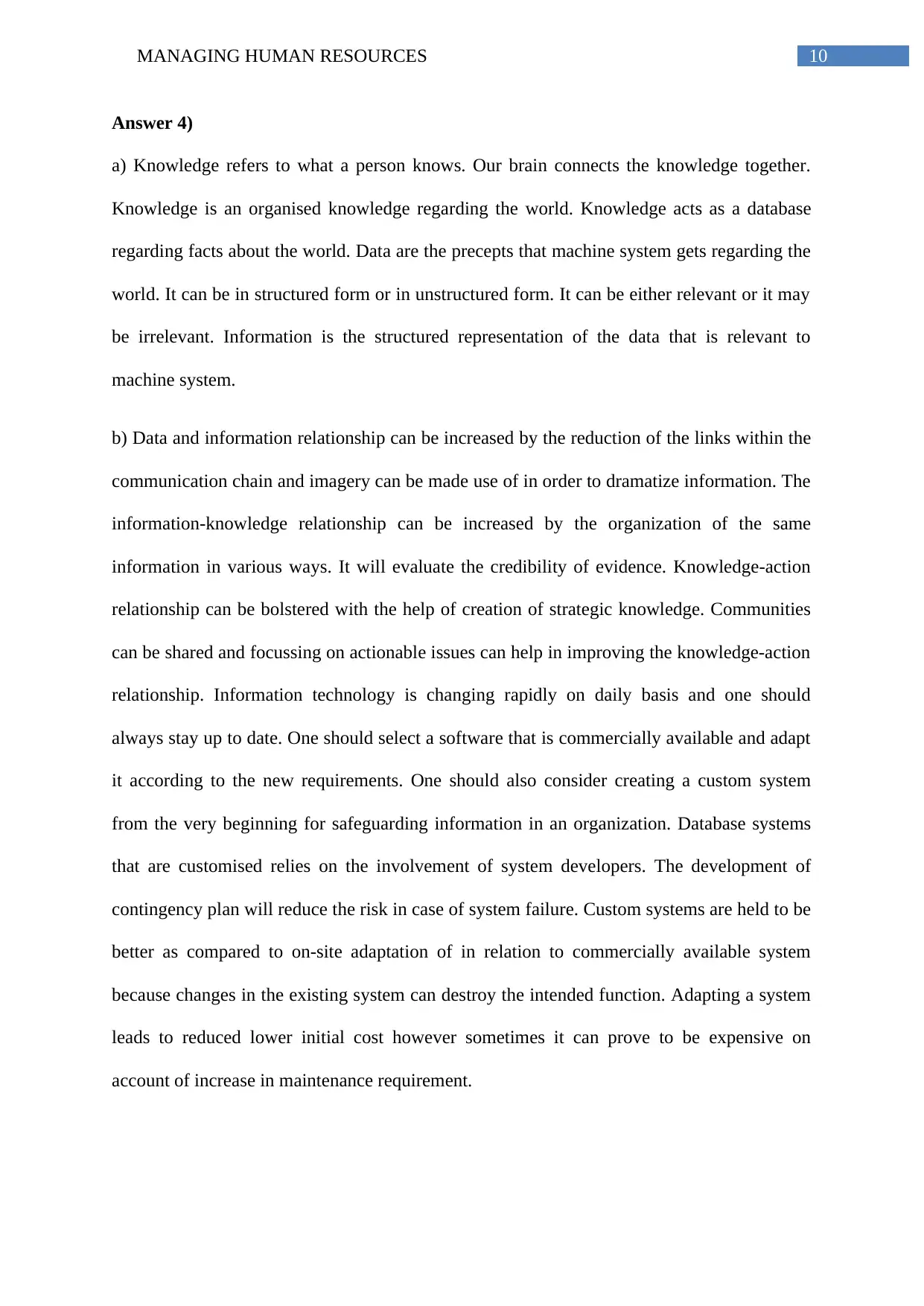
10MANAGING HUMAN RESOURCES
Answer 4)
a) Knowledge refers to what a person knows. Our brain connects the knowledge together.
Knowledge is an organised knowledge regarding the world. Knowledge acts as a database
regarding facts about the world. Data are the precepts that machine system gets regarding the
world. It can be in structured form or in unstructured form. It can be either relevant or it may
be irrelevant. Information is the structured representation of the data that is relevant to
machine system.
b) Data and information relationship can be increased by the reduction of the links within the
communication chain and imagery can be made use of in order to dramatize information. The
information-knowledge relationship can be increased by the organization of the same
information in various ways. It will evaluate the credibility of evidence. Knowledge-action
relationship can be bolstered with the help of creation of strategic knowledge. Communities
can be shared and focussing on actionable issues can help in improving the knowledge-action
relationship. Information technology is changing rapidly on daily basis and one should
always stay up to date. One should select a software that is commercially available and adapt
it according to the new requirements. One should also consider creating a custom system
from the very beginning for safeguarding information in an organization. Database systems
that are customised relies on the involvement of system developers. The development of
contingency plan will reduce the risk in case of system failure. Custom systems are held to be
better as compared to on-site adaptation of in relation to commercially available system
because changes in the existing system can destroy the intended function. Adapting a system
leads to reduced lower initial cost however sometimes it can prove to be expensive on
account of increase in maintenance requirement.
Answer 4)
a) Knowledge refers to what a person knows. Our brain connects the knowledge together.
Knowledge is an organised knowledge regarding the world. Knowledge acts as a database
regarding facts about the world. Data are the precepts that machine system gets regarding the
world. It can be in structured form or in unstructured form. It can be either relevant or it may
be irrelevant. Information is the structured representation of the data that is relevant to
machine system.
b) Data and information relationship can be increased by the reduction of the links within the
communication chain and imagery can be made use of in order to dramatize information. The
information-knowledge relationship can be increased by the organization of the same
information in various ways. It will evaluate the credibility of evidence. Knowledge-action
relationship can be bolstered with the help of creation of strategic knowledge. Communities
can be shared and focussing on actionable issues can help in improving the knowledge-action
relationship. Information technology is changing rapidly on daily basis and one should
always stay up to date. One should select a software that is commercially available and adapt
it according to the new requirements. One should also consider creating a custom system
from the very beginning for safeguarding information in an organization. Database systems
that are customised relies on the involvement of system developers. The development of
contingency plan will reduce the risk in case of system failure. Custom systems are held to be
better as compared to on-site adaptation of in relation to commercially available system
because changes in the existing system can destroy the intended function. Adapting a system
leads to reduced lower initial cost however sometimes it can prove to be expensive on
account of increase in maintenance requirement.
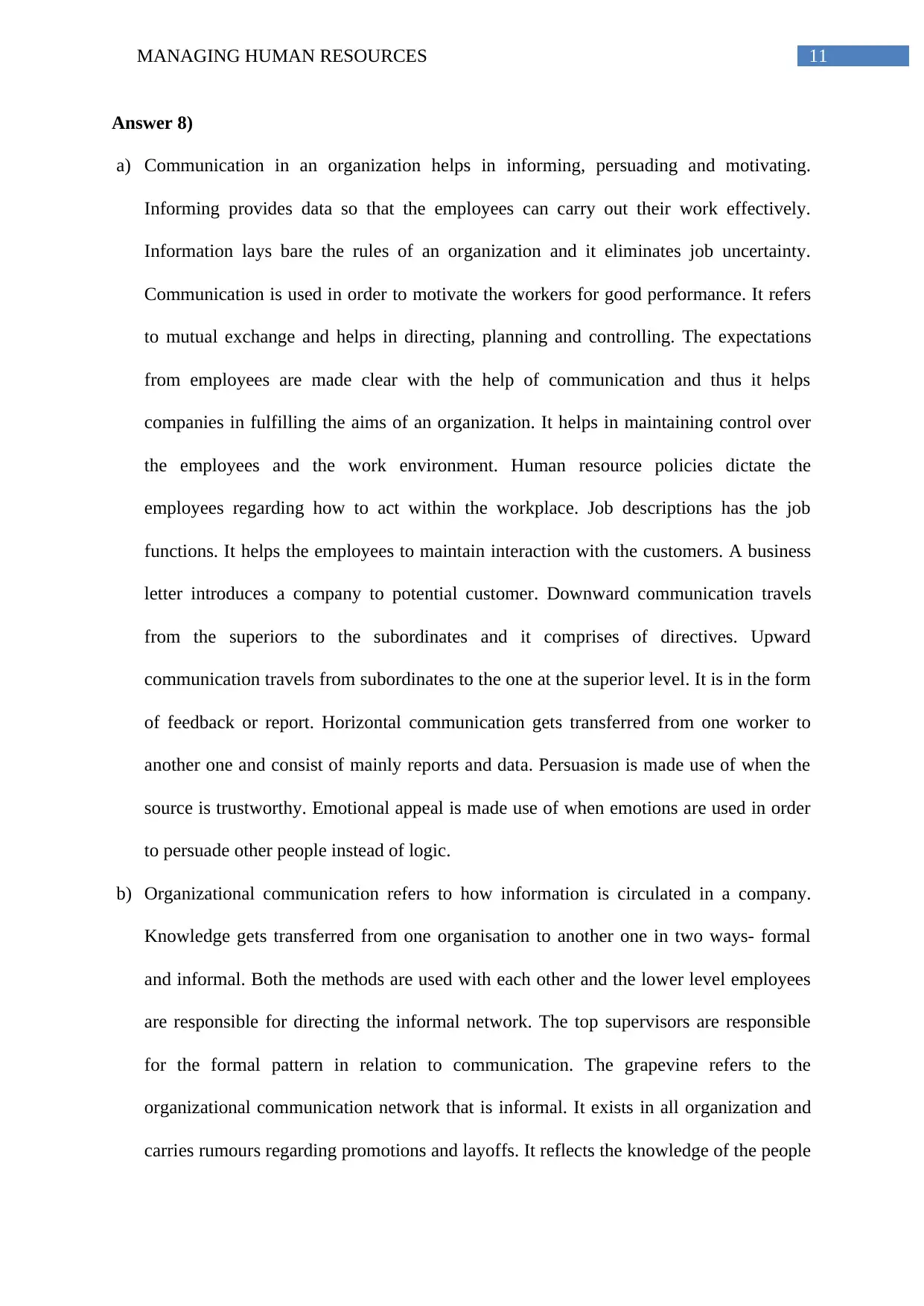
11MANAGING HUMAN RESOURCES
Answer 8)
a) Communication in an organization helps in informing, persuading and motivating.
Informing provides data so that the employees can carry out their work effectively.
Information lays bare the rules of an organization and it eliminates job uncertainty.
Communication is used in order to motivate the workers for good performance. It refers
to mutual exchange and helps in directing, planning and controlling. The expectations
from employees are made clear with the help of communication and thus it helps
companies in fulfilling the aims of an organization. It helps in maintaining control over
the employees and the work environment. Human resource policies dictate the
employees regarding how to act within the workplace. Job descriptions has the job
functions. It helps the employees to maintain interaction with the customers. A business
letter introduces a company to potential customer. Downward communication travels
from the superiors to the subordinates and it comprises of directives. Upward
communication travels from subordinates to the one at the superior level. It is in the form
of feedback or report. Horizontal communication gets transferred from one worker to
another one and consist of mainly reports and data. Persuasion is made use of when the
source is trustworthy. Emotional appeal is made use of when emotions are used in order
to persuade other people instead of logic.
b) Organizational communication refers to how information is circulated in a company.
Knowledge gets transferred from one organisation to another one in two ways- formal
and informal. Both the methods are used with each other and the lower level employees
are responsible for directing the informal network. The top supervisors are responsible
for the formal pattern in relation to communication. The grapevine refers to the
organizational communication network that is informal. It exists in all organization and
carries rumours regarding promotions and layoffs. It reflects the knowledge of the people
Answer 8)
a) Communication in an organization helps in informing, persuading and motivating.
Informing provides data so that the employees can carry out their work effectively.
Information lays bare the rules of an organization and it eliminates job uncertainty.
Communication is used in order to motivate the workers for good performance. It refers
to mutual exchange and helps in directing, planning and controlling. The expectations
from employees are made clear with the help of communication and thus it helps
companies in fulfilling the aims of an organization. It helps in maintaining control over
the employees and the work environment. Human resource policies dictate the
employees regarding how to act within the workplace. Job descriptions has the job
functions. It helps the employees to maintain interaction with the customers. A business
letter introduces a company to potential customer. Downward communication travels
from the superiors to the subordinates and it comprises of directives. Upward
communication travels from subordinates to the one at the superior level. It is in the form
of feedback or report. Horizontal communication gets transferred from one worker to
another one and consist of mainly reports and data. Persuasion is made use of when the
source is trustworthy. Emotional appeal is made use of when emotions are used in order
to persuade other people instead of logic.
b) Organizational communication refers to how information is circulated in a company.
Knowledge gets transferred from one organisation to another one in two ways- formal
and informal. Both the methods are used with each other and the lower level employees
are responsible for directing the informal network. The top supervisors are responsible
for the formal pattern in relation to communication. The grapevine refers to the
organizational communication network that is informal. It exists in all organization and
carries rumours regarding promotions and layoffs. It reflects the knowledge of the people
⊘ This is a preview!⊘
Do you want full access?
Subscribe today to unlock all pages.

Trusted by 1+ million students worldwide
1 out of 13
Related Documents
Your All-in-One AI-Powered Toolkit for Academic Success.
+13062052269
info@desklib.com
Available 24*7 on WhatsApp / Email
![[object Object]](/_next/static/media/star-bottom.7253800d.svg)
Unlock your academic potential
Copyright © 2020–2025 A2Z Services. All Rights Reserved. Developed and managed by ZUCOL.





